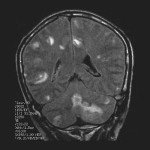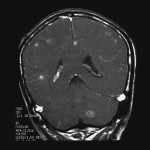The set of cranial MRI (coronal cuts) shown here are from a patient presenting with fever and confusion. Multiple, ring-enhancing nodular lesions are noted in the FLAIR sequence (Figures 1 and 2) as well as in the T1W imaging with contrast (Figures 3 and 4). Serology was positive for toxoplasma and the patient was tested to be HIV positive.
Toxoplasmosis is caused by the intracellular parasite Toxoplasma gondii. Although any mammal can be a carrier of the parasite and thus act as an intermediate host, cats are the definitive host. Humans become infected when the organism is accidentally ingested.
CNS toxoplasmosis most commonly involves the basal ganglia, thalami, grey-white matter junctions and cerebellum. Lesions are often multifocal and most lesions are small, averaging 2-3cm in diameter.
Toxoplasmosis of the central nervous system is the leading cause of focal central nervous system disease in patients with AIDS with primary central nervous system lymphoma being a major differential diagnosis. However, in contrast to toxoplasmosis, primary CNS lymphomas are often solitary. Lesions are located at the basal ganglia and deep white matter, often abutting the lateral ventricles and crossing the corpus callosum.
- Figure 1
- Figure 2
- Figure 3
- Figure 4
 HKU E-learning Platform in Clinical Neurosciences HKU eLearning Platform in Clinical Neurosciences
HKU E-learning Platform in Clinical Neurosciences HKU eLearning Platform in Clinical Neurosciences




